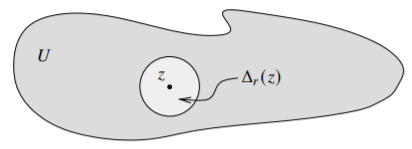4.1: The Generalized Cauchy Integral Formula
- Page ID
- 74238
Before we get into the \(\bar{\partial}\)-problem, let us prove a more general version of Cauchy’s formula using Stokes’ theorem (really Green’s theorem). This version is called the Cauchy-Pompeiu integral formula. We only need the theorem for smooth functions, but as it is often applied in less regular contexts and it is just an application of Stokes’ theorem, let us state it more generally. In applications, the boundary is often only piecewise smooth, and again that is all we need for Stokes.
Let \(U \subset \mathbb{C}\) be a bounded open set with piecewise-\(C^1\) boundary \(\partial U\) oriented positively (see appendix B), and let \(f \colon \overline{U} \to \mathbb{C}\) be continuous with bounded continuous partial derivatives in \(U\). Then for \(z \in U\): \[f(z) = \frac{1}{2\pi i} \int_{\partial U} \frac{f(\zeta)}{\zeta-z} \, d \zeta + \frac{1}{2\pi i} \int_{U} \frac{\frac{\partial f}{\partial \bar{\zeta}}(\zeta)}{\zeta-z} \, d\zeta \wedge d\bar{\zeta} .\]
- Proof
-
Fix \(z \in U\). We wish to apply Stokes’ theorem\(^{1}\), but the integrand is not smooth at \(z\). Let \(\Delta_r(z)\) be a small disc such that \(\Delta_r(z) \subset \subset U\). See Figure \(\PageIndex{1}\). Stokes now applies on \(U \setminus \Delta_r(z)\).

Figure \(\PageIndex{1}\)
Via Stokes, \[\int_{\partial U} \frac{f(\zeta)}{\zeta-z}\, d\zeta - \int_{\partial \Delta_r(z)} \frac{f(\zeta)}{\zeta-z}\, d\zeta = \int_{U \setminus \Delta_r(z)} d\left( \frac{f(\zeta)}{\zeta-z} \, d\zeta \right) = \int_{U \setminus \Delta_r(z)} \frac{\frac{\partial f}{\partial \bar{\zeta}}(\zeta)}{\zeta-z} \, d\bar{\zeta} \wedge d\zeta .\] The second equality follows because holomorphic derivatives in \(\zeta\) have a \(d\zeta\) and when we wedge them with \(d\zeta\) we just get zero. We now wish to let the radius \(r\) go to zero. Via the exercise above, \(\frac{\frac{\partial f}{\partial \bar{\zeta}}(\zeta)}{\zeta-z} \, d\bar{\zeta} \wedge d\zeta\) is integrable over all of \(U\). Therefore, \[\lim_{r \to 0} \int_{U \setminus \Delta_r(z)} \frac{\frac{\partial f}{\partial \bar{\zeta}}(\zeta)}{\zeta-z} \, d\bar{\zeta} \wedge d\zeta = \int_{U} \frac{\frac{\partial f}{\partial \bar{\zeta}}(\zeta)}{\zeta-z} \, d\bar{\zeta} \wedge d\zeta = - \int_{U} \frac{\frac{\partial f}{\partial \bar{\zeta}}(\zeta)}{\zeta-z} \, d\zeta \wedge d\bar{\zeta} .\] The second equality is simply swapping the order of \(d\zeta\) and \(d\bar{\zeta}\). By continuity of \(f\), \[\lim_{r \to 0} \frac{1}{2\pi i} \int_{\partial \Delta_r(z)} \frac{f(\zeta)}{\zeta-z}\, d\zeta = \lim_{r \to 0} \frac{1}{2\pi} \int_0^{2\pi} f(z + r e^{i\theta})\, d\theta = f(z) .\] The theorem follows.
If \(f\) is holomorphic, then the second term is zero, and we obtain the standard Cauchy formula. If \(\zeta = x+iy\), then the standard orientation on \(\mathbb{C}\) is the one corresponding to the area form \(dA = dx \wedge dy\). The form \(d\zeta \wedge d\bar{\zeta}\) is the area form up to a scalar. That is, \[d\zeta \wedge d\bar{\zeta} = (dx+i\,dy)\wedge (dx-i\,dy) = (- 2 i ) dx \wedge dy = (-2i) dA .\]
As we want to use Stokes, we need to write the standard exterior derivative in terms of \(z\) and \(\bar{z}\). For \(z = x+iy\), we compute: \[d \psi = \frac{\partial \psi}{\partial x} dx + \frac{\partial \psi}{\partial y} dy = \frac{\partial \psi}{\partial z} dz + \frac{\partial \psi}{\partial \bar{z}} d\bar{z}.\]
Observe the singularity in the second term of the Cauchy–Pompeiu formula, and prove that the integral still makes sense (the function is integrable). Hint: polar coordinates.
Why can we not differentiate in \(\bar{z}\) under the integral in the second term of the Cauchy–Pompeiu formula? Notice that it would lead to an impossible result.
- Let \(U \subset \mathbb{C}\) be a bounded open set with piecewise-\(C^1\) boundary and suppose \(f \colon \overline{U} \to \mathbb{C}\) is a \(C^1\) function such that \(\int_{U} \frac{\frac{\partial f}{\partial \bar{z}}(\zeta)}{\zeta-z} \, dA(\zeta) = 0\) for every \(z \in \partial U\). Prove that \(f|_{\partial U}\) are the boundary values of a holomorphic function in \(U\).
- Given arbitrary \(\epsilon > 0\), find a \(C^1\) function \(f\) on the closed unit disc \(\overline{\mathbb{D}}\), such that \(\frac{\partial f}{\partial \bar{z}}\) is identically zero outside an \(\epsilon\)-neighborhood of the origin, yet \(f|_{\partial \mathbb{D}}\) are not the boundary values of a holomorphic function.
Let \(U \subset \mathbb{C}\) and \(f\) be as in the theorem, but let \(z \notin \overline{U}\). Show that \[\frac{1}{2\pi i} \int_{\partial U} \frac{f(\zeta)}{\zeta-z} \, d \zeta + \frac{1}{2\pi i} \int_{U} \frac{\frac{\partial f}{\partial \bar{\zeta}}(\zeta)}{\zeta-z} \, d\zeta \wedge d\bar{\zeta} = 0 .\]
Footnotes
[1] We are really using Green’s theorem, which is the generalized Stokes’ theorem in 2 dimensions, see Theorem B.2.


